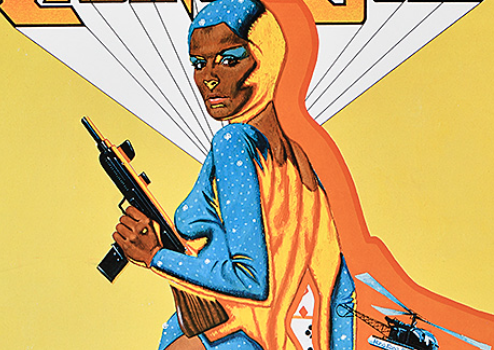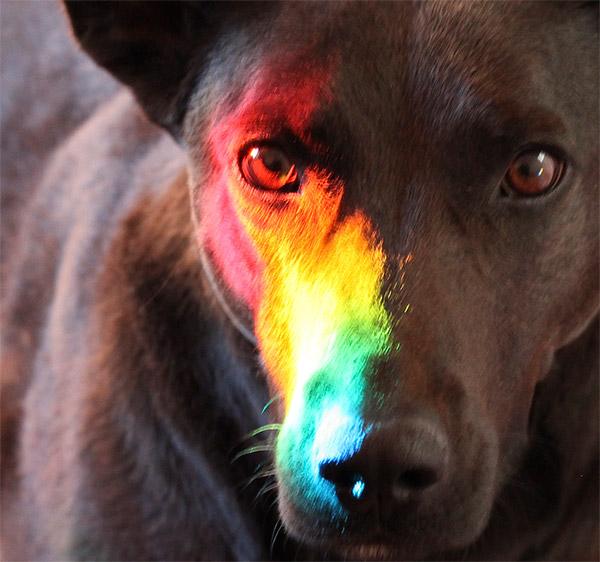For this assignment, we had to select a photographer, illustrator, creative director, visual artist or designer. And research their life about education and background related to their work. Discuss the individual’s creative process and any influences on their work from other artists, cultural movements, trends, or fields. If they have well-known clients or exhibits, discuss those and any award his/she has garnered, etc.
I chose to write about Keith Haring because he was an influential to the art world. Keith Haring was a very popular artist and activist who was part of the legendary New York art scene during the 1980s. While he is known for his colourful works and his iconic motifs, much of his work responded to contemporary social and political events.
Keith Haring, does it sound familiar? You probably saw his art at a museum or saw his unique pieces by scrolling through one of your many social media platforms without realizing that you just saw a piece of art done by one of the most influential people in contemporary art. Haring’s pop and graffiti-like work grew out of New York City street culture in the 1980s. His art is instantly recognizable for its simple aesthetic and line drawing technique. Haring wasn’t afraid to portray and publicize controversial topics like war, sexuality, life, and death. Haring’s impact on the art world changed how we see art today. Sadly, Haring passed away at a young age at just 31, due to aid-related complications. But Haring was determined to live in the moment throughout his life, a quality many tend to lose. One thing for sure, Keith never really grew into maturity. Instead, he remained a young soul, seen through his art.
Keith Haring was an American artist born on May 4, 1958. At a very young age, Haring developed a love for art to draw a bunch of cartoonish drawings. He was inspired by everything that surrounded him. Haring was part of the first generation of the space age where events like the first moon landing, protests, and other political issues occurred. Haring was inspired by these events, as seen in his work. Those inspirations lead to his most recognizable figures to date, such as the flying saucers, computer screens, and nuclear symbols.
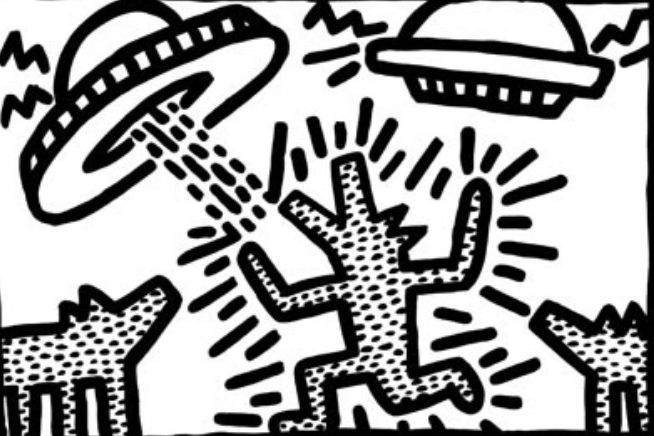
Flying Saucer
Source: The Keith Haring Foundation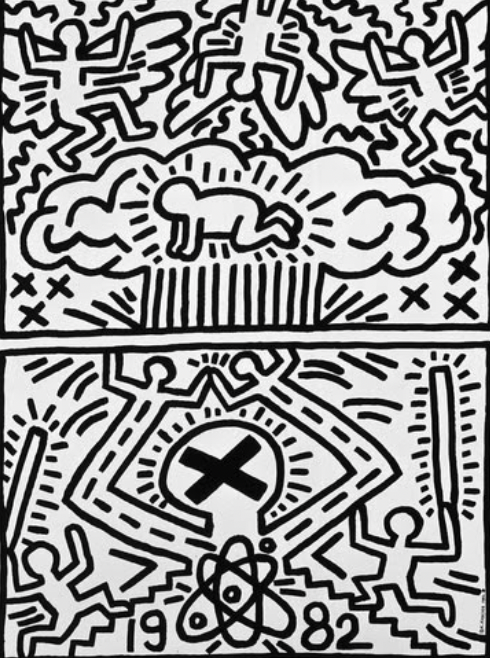
Anti-Nuclear Rally
Source: The Keith Haring Foundation
Untitled 1983
Source: The Keith Haring Foundation
Haring was always passionate about his craft, so he moved to New York City in 1978 to study visual arts. Moving to NYC was fascinating to him, with all the graffiti he saw all over the streets. Graffiti was everywhere during the 70s and 80s. Keith defined graffiti as “this incredible mastery of drawing which totally blew me away.” (Gruen)
Ever since becoming an art student, Keith rejected anything he saw as the “elitist” conventions of a gallery and museum system. Keith instead found graffiti and street art just as exciting and educational as what he was going to see at a gallery. Keith admired graffiti so much he stated, “sometimes I wouldn’t even get on the first train. I’d sit and wait to see what was on the next train.” (Gruen) Referring to subway carts that were covered with graffiti. And it wasn’t till 1980 when Keith Haring started to draw his art all around these stations. With a piece of white chalk on his hand and an empty black panel that covered old advertisements. He would draw a cartoon-like drawing where he would finish in 2 minutes and then move on to another station. Haring would do about 30 drawings in a day. These drawings would be utterly different from one another but similar in ways. Haring just wanted millions to see it, and a lot of people did. He quoted, “You don’t have to know anything about art to appreciate it or look at it.” (Osgood) It was a daily routine for Haring to find empty black panels and draw quickly. By Keith’s 20s, his chalk subway drawings made him into a massive star.
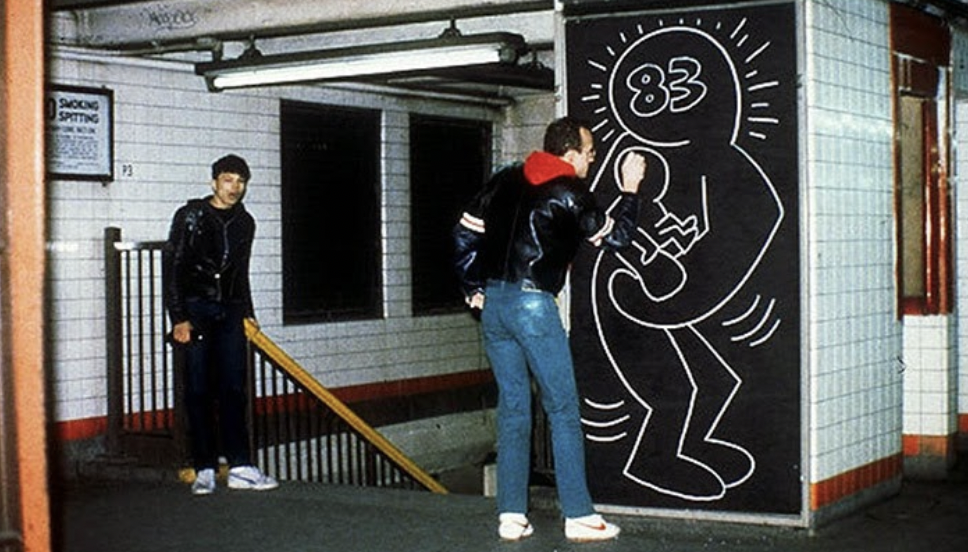
Keith haring in NYC Subway,NY,1984
Source: Tseng Kwong Chi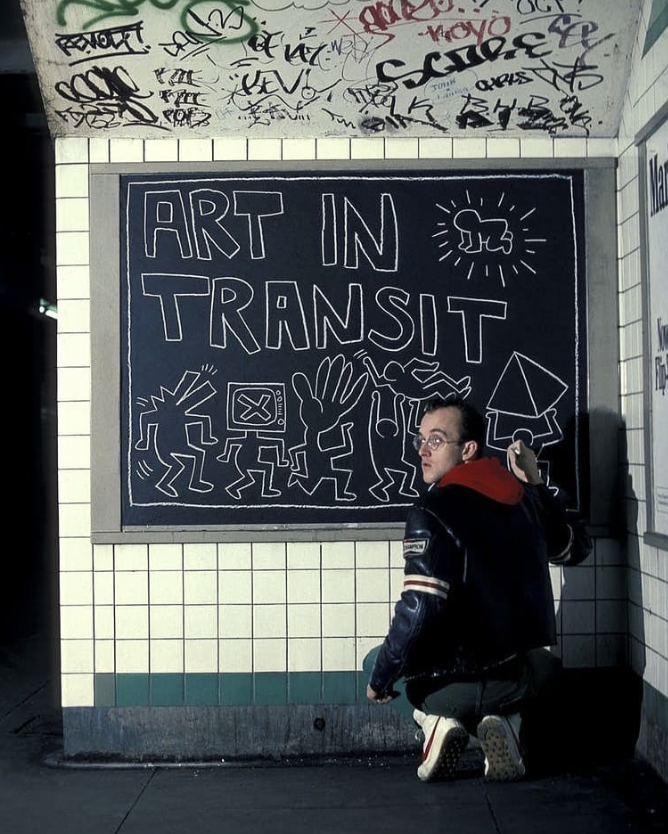
Keith haring in NYC Subway,NY,1984
Source: Tseng Kwong Chi
It didn’t take long for magazines and newspapers to issue him a cover, MTV offering him an appearance, Haring’s art was everywhere you went. “I think I was born an artist. I think I have a responsibility to live up to that. My contribution to the world is my ability to draw. I will draw as much as I can for as many people as I can for as long as I can.” (journal) And he did just that in a short period he started to create many of his famous works. Haring was gifted; his work was based on current moods, feelings, and thoughts. Haring was fast and would often make tons of artwork in a single day. Haring’s art indeed marked a moment when popular culture absorbed high art. Haring invented a new roam of universal illustrated language in his unique way. Haring’s work inspirations come from “famous artists such as Matisse, Alechinsky, Picasso, cartoons, and even calligraphy.” (Paparoni) Which can be seen through his art.
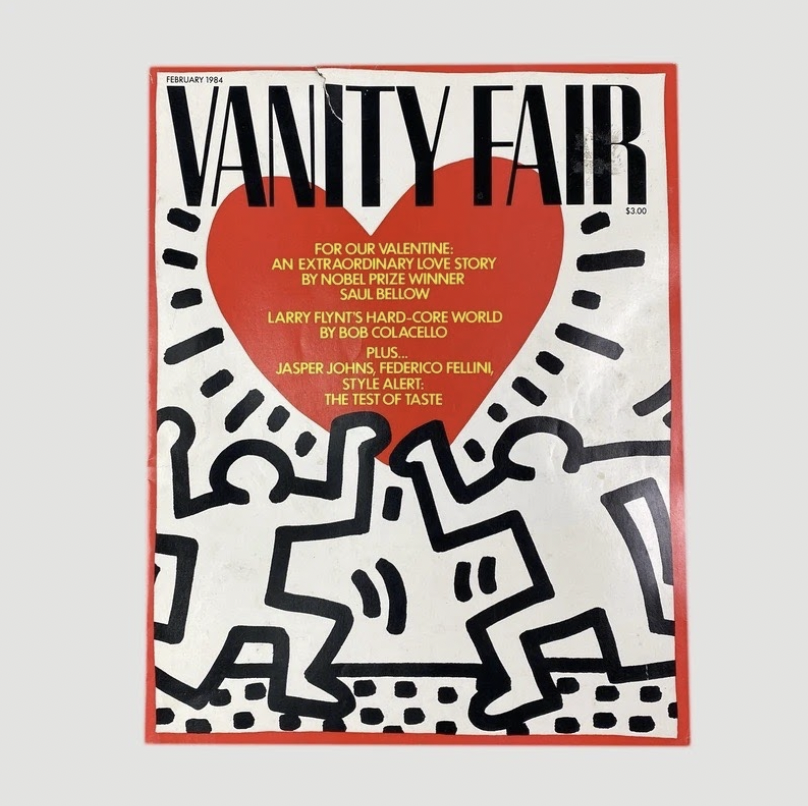
Source: Unified Goods
One of Haring’s famous pieces is a mural still located in NYC called “Crack is Wack,” created in 1986. This double-sided mural has become very iconic in the city of New York. It has marked its places ever since Haring created it. Haring’s inspiration behind the mural was due to a friend named Benny, who became addicted to crack; he painted it after many failed attempts to help him curb his addiction. Haring’s mural portrayed his frustrations with the ineffective government in handling the epidemic of crack that was taking place in the country but especially in New York. The anti-crack painting was created to bring attention to the drug-related issue. The 16-by-26- foot mural can be found in East Harlem, remaining in its original place in bright orange on one side and the other in plain white with instantly recognizable outlined figures in black. Haring never described what every figure meant in his art, but it all related to how he was feeling in the moment. In “crack is wack,” you can see the gruesome depiction of drugs with a novelty type.
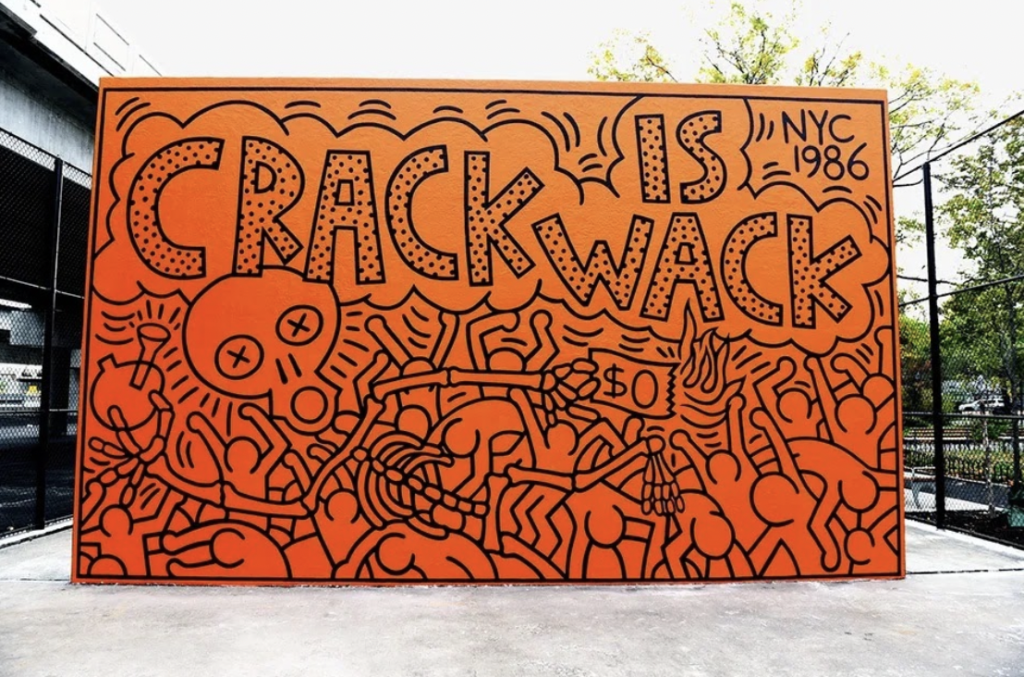
Crack is Wack Mural by Keith Haring, 1986
Source: NYC Parks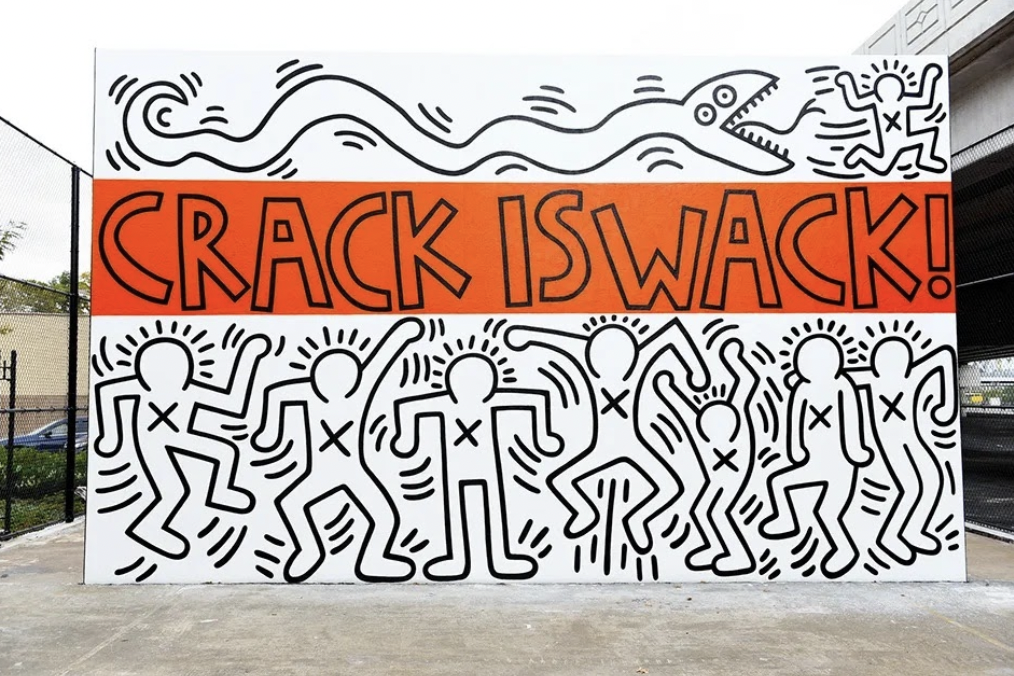
Crack is Wack Mural by Keith Haring, 1986
Source: NYC Parks
As Haring was getting heavily recognized by the public. Art institutions and museums had a lot to say about his work, saying it was not “high enough” for the elite. Keith Haring did not care; Keith made art for everyone to enjoy no matter who you were. He said, “The public has a right to art/The public is being ignored by most contemporary artists/Art is for everybody.” (sawyer)
The majority of Keith Haring’s art is very political; he was not afraid to stand up for what was right. In 1985 Keith Haring made one of his recognizable pieces named “Free South Africa.” This piece is an example of how Keith Haring uses his figurative drawings to address social injustices across the world. “Free south africa” tackles the topic of racism and apartheid in South Africa. Haring did everything possible to mobilise support against apartheid. Keith was a strong advocate. He printed about 20,000 “Free South Africa” posters and distributed them all over New York. He was very vocal on the issue, saying, “Control is evil. All stories of white men’s ‘expansion’ and ‘colonisation’ and ‘domination’ are filled with horrific details of the abuse of power and the misuse of people.” (myartbroker) “Free South Africa” clearly demonstrated this using his bold linear style. Haring represents the relationship between “the black majority and white minority in South Africa during years of institutionalized racial segregation” (myartbroker). The black figure is larger than the white figure, depicting the vast difference between the black majority and the few white people who had political and social power during that time. “Free South Africa” shows this inequality of the “white man’s” power by the white figure with a rope hanging around the black figure’s neck. Keith expressed himself in the simplest way where his messages like “Free South Africa” were conveyed just by raw figures.
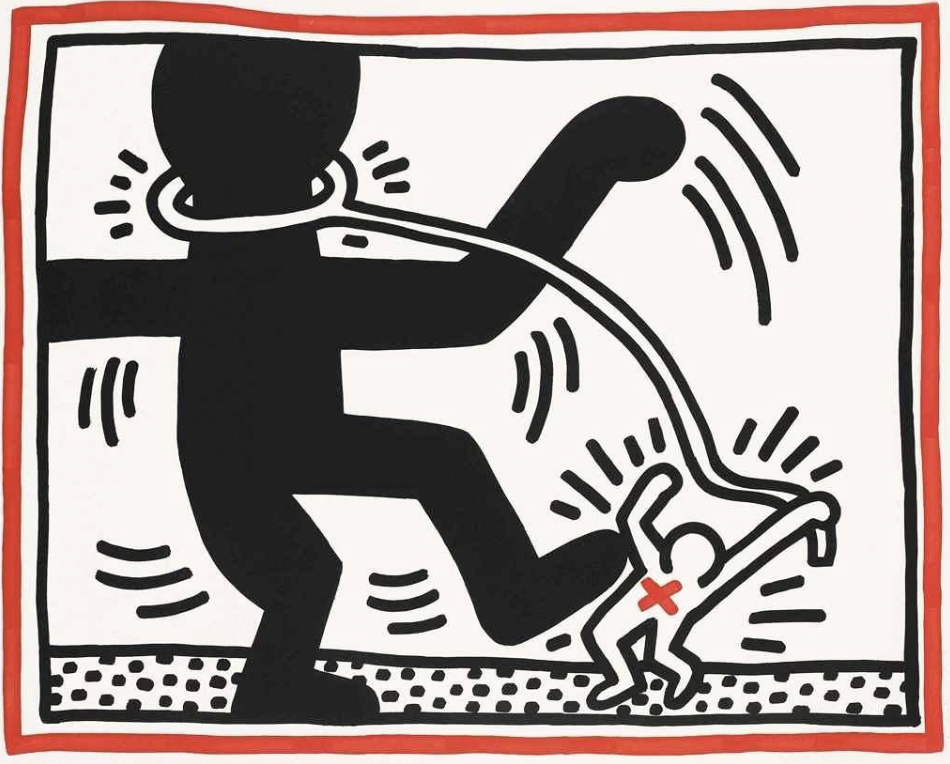
Source : The Keith Haring Foundation
Haring will always be remembered as an artist who neglected convention and elitism to bring art to the streets and its people (Fields). It wasn’t until Haring’s HIV diagnosis in 1987 that helped propel the work of history’s best-known street-artists-turned-AIDS-activists. During the early 80s, the world was going through a rough time with the HIV/AIDS epidemic. The words HIV/AIDS soon became synonymous with fear, stigma, and death. Those affected the most were gay communities across America and the world. Yet, the disease hit New York severely hard and fast. As Haring and his circle saw more and more friends fall sick and then die from AIDS, “it motivated them to keep creating with whatever time they had.” (Fields) Eventually, the virus got to Haring at the age of just 29. But like no other, Haring was not going to allow this virus to devastate him and his craft. He instead was more motivated than ever before to make art non-stop.
His work around this time was many paintings that depicted sexual acts and phallic line drawings, which created attention and awareness of HIV/AIDS, and promoted safe sex campaigns. Yet, many of these pieces contained a good amount of darkness. Harings 1989 “Stop Aids” depicts the message clearly with two green figures forming a scissor cutting up the red snake in a muted color palette, signifying people to unite to end HIV/AIDS. Haring was very open about his status and was not afraid to speak about it. It was huge since nobody famous came out and talked about their status like Haring was. This was brave of him.
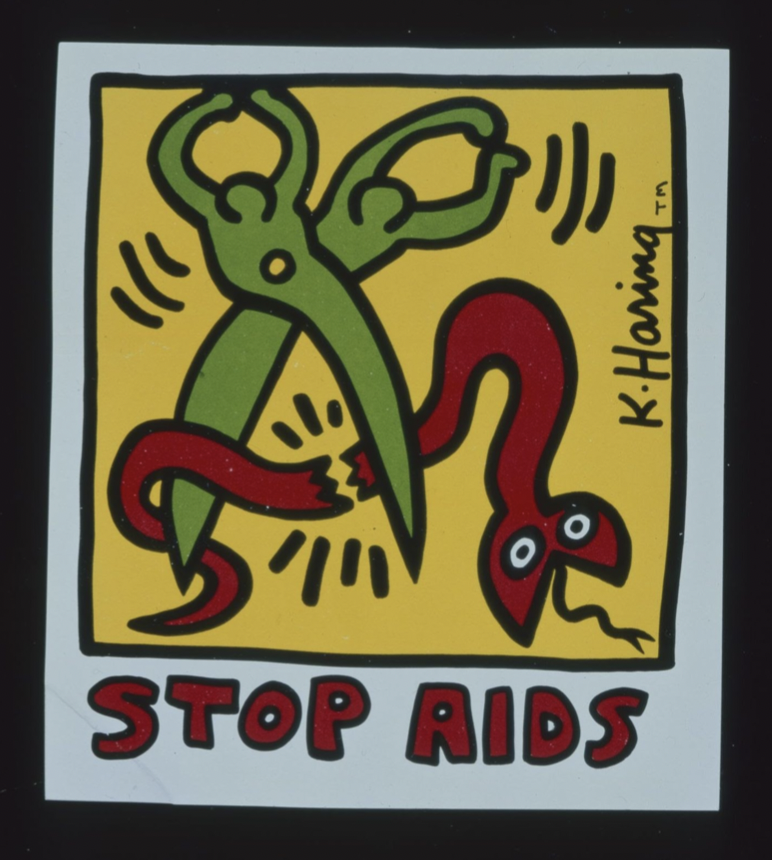
Source: The Keith Haring Foundation
Haring’s HIV/AIDS art goes on, but the most heavily notable one is the “Ignorance = Fear/Silence = Death: Fight Aids Act Up” poster in 1989. Ten thousand posters were printed and were utilized by ACT UP in a massive campaign across New York City in 1990. New Yorkers saw this poster everywhere on billboards, subways, and buildings. The 24×43 in muted color poster design has three figures in yellow replicating the well-known “see no evil, hear no evil, speak no evil” 3 monkeys, portraying the struggles faced by those living with HIV/AIDS. And “the oppressive government, religious and health institutions that failed to respond to and properly acknowledge the epidemic throughout the 1980s and 1990’s” (Boo-Hooray). Additionally, ACT UP’s now-iconic slogans, “Silence = Death” and “Ignorance = Fear,” Haring’s design urged people to act up and fight AIDS.
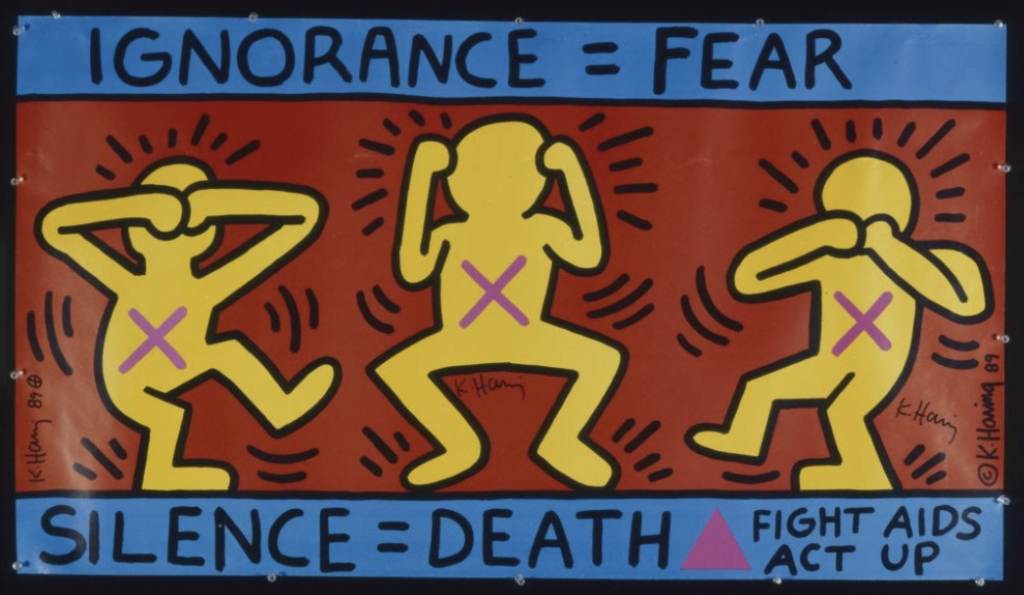
Source: The Keith Haring Foundation
Haring might not be here with us anymore, but his legacy continues. Haring influenced pop art with his bold and graphical imagery that has become instantly recognizable. Keith Haring’s art has made statements through the years and has changed the art world with his cartoon-like graffiti style, which recognized street art. Today you can see Keith Haring’s art on display in specific museum locations, but you can also see works outside in the open.
WORKS CITED
Thompson, Robert Farris, and Shepard Fairey. Keith Haring: Journals 2010. Penguin Books, 2010.
Gruen, John. “Conversation with Keith Haring.” Conversation with Keith Haring | Keith Haring, The Keith Haring Foundation, 2005, https://www.haring.com/!/selected_writing/conversation-with-keith-haring.
Osgood, Charles. “Keith Haring: How A Furtive Artist Invaded the Art World.” CBS News, CBS Interactive, 25 Sept. 2016, https://www.cbsnews.com/news/keith-haring-how-a-furtive-artist-invaded-the-art-world/.
Paparoni, Demetrio. “On the Shoulders of Giants. Keith Haring.” On the Shoulders of Giants. Keith Haring | Keith Haring, The Keith Haring Foundation, 2005, https://www.haring.com/!/selected_writing/on-the-shoulders-of-giants-keith-haring
Sawyer, Miranda. “The Public Has a Right to Art: The Radical Joy of Keith Haring.” The Guardian, Guardian News and Media, 2 June 2019, https://www.theguardian.com/artanddesign/2019/jun/02/public-has-right-to-art-keith-haring-tate-liverpool-exhibition.
“Free South Africa by Keith Haring.” MyArtBroker, 17 Mar. 2021, https://www.myartbroker.com/artist/keith-haring/free-south-africa/.
Fields, Liz. “Facing Death from AIDS, Keith Haring Kept Creating.” PBS, Public Broadcasting Service, 30 Nov. 2020, https://www.pbs.org/wnet/americanmasters/facing-death-from-aids-keith-haring-kept-creating/16169/.
“Ignorance = Fear / Silence = Death: Fight Aids Act up by Keith Haring on Boo-Hooray.” Boo-Hooray, Bibliopolis, 2019, https://www.boo-hooray.com/pages/books/5775/keith-haring/ignorance-fear-silence-death-fight-aids-act-up.
Haring, Keith. “Stop AIDS, 1989 – Keith Haring.” Www.wikiart.org, Xennex, 11 Oct. 2018, https://www.wikiart.org/en/keith-haring/stop-aids-1989.
“Success.” Success | Keith Haring, The Keith Haring Foundation, https://www.haring.com/!/about-haring/success.
Blanché, Ulrich. “Keith Haring – A Street Artist?” Urban Creativity, http://www.urbancreativity.org/uploads/1/0/7/2/10727553/u.blanche_sauc_vol2_n1.pdf.
Cox, Savannah. “The Story behind Keith Haring’s Original ‘Crack Is Wack’ Mural.” All That’s Interesting, All That’s Interesting, 13 June 2015, https://allthatsinteresting.com/crack-is-wack-mural.
McGrath, Katherine. “Keith Haring’s Crack Is Wack Mural in New York City Gets a Second Life.” Architectural Digest, Architectural Digest, 19 Aug. 2019, https://www.architecturaldigest.com/story/crack-is-wack-keith-haring-mural-in-new-york-city-gets-second-life.
Gray, Steve. “Street Art Legends: Best of Keith Haring Art.” Widewalls, 2015, https://www.widewalls.ch/magazine/street-art-legends-best-of-keith-haring-art/keith-haring-crack-is-wack-mural.
Tsui, Denise. “When Drawing Creates Life: What We Can Learn from Keith Haring.” COBO Social, 8 Oct. 2020, https://www.cobosocial.com/dossiers/keith-haring-ngv/.

